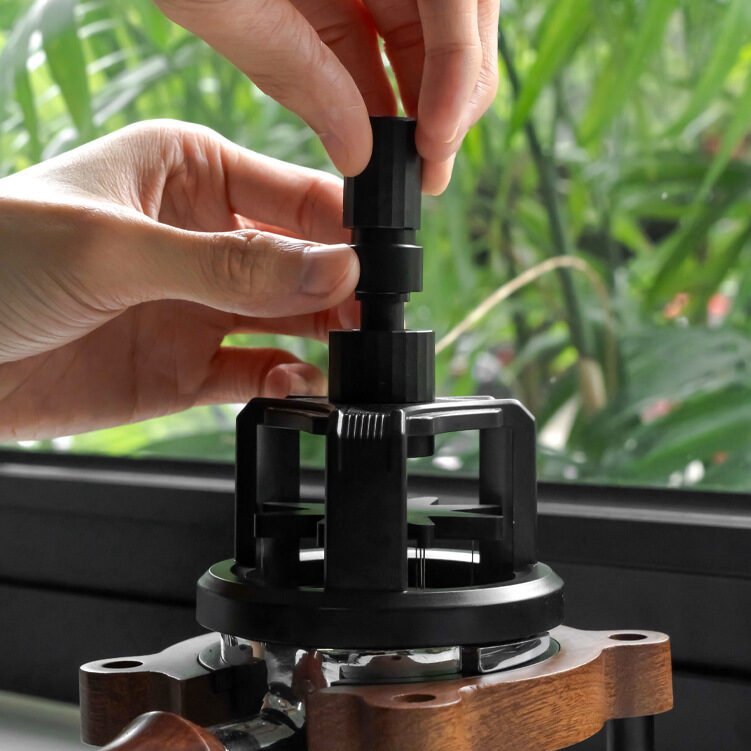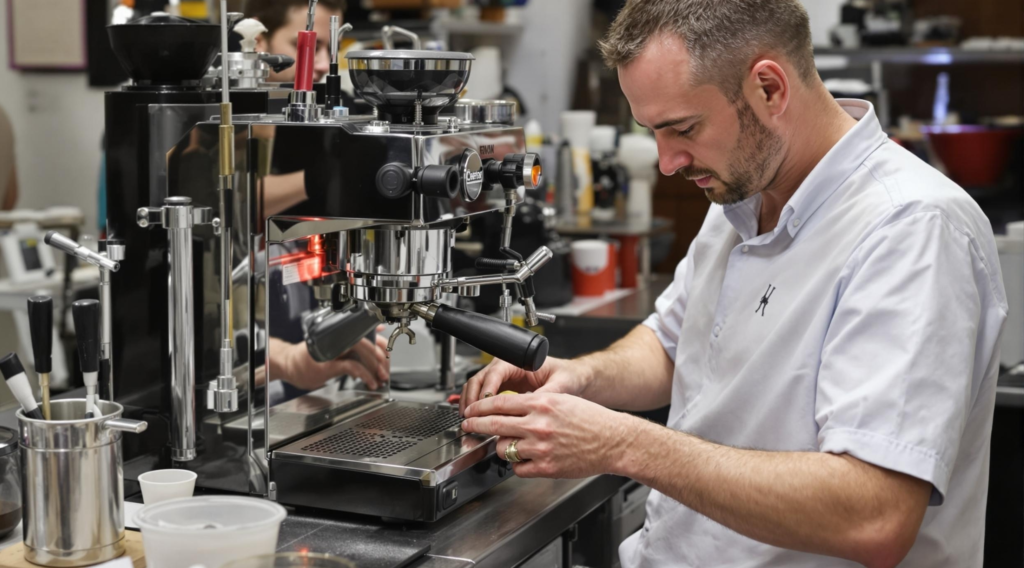Are you frustrated with inconsistent espresso shots despite your best efforts? Channeling and uneven extraction can ruin even the most carefully selected beans, leaving you with bitter or sour results.
A WDT tool (Weiss Distribution Technique tool) is a precision coffee accessory used to evenly distribute grounds in your portafilter before tamping. It breaks up clumps and eliminates channels, resulting in more balanced extraction and significantly improved espresso flavor profiles.

If you've invested in quality beans and equipment but still experience inconsistent shots, the problem might be in your distribution technique. Let me share why this simple tool has become indispensable for serious baristas and home enthusiasts alike.
What exactly does a WDT tool do in espresso preparation?
Every barista knows the frustration of watching espresso channel through the puck, creating over-extracted bitter patches alongside under-extracted sour areas. This inconsistency ruins shots and wastes expensive coffee beans.
A WDT tool uses fine needles or pins to break up clumps in coffee grounds and create a perfectly even bed of coffee in the portafilter. This eliminates density variations that cause channeling, where water takes the path of least resistance through your coffee puck.

The Science Behind WDT's Effectiveness
WDT was developed by John Weiss on Home-Barista.com forums around 2005 as a solution to distribution problems. The technique addresses a fundamental challenge in espresso preparation: achieving uniform density throughout the coffee puck.
When coffee is ground, it naturally forms clumps due to static electricity and moisture. These clumps create density variations that lead to uneven water flow during extraction. Even high-end grinders produce some clumping, especially with darker roasts or oilier beans.
The WDT technique uses thin needles (typically 0.3-0.4mm in diameter) to gently stir the grounds, breaking up clumps while minimizing compression. This creates a coffee bed with consistent density throughout, allowing water to flow evenly during extraction.
Benefits of WDT for Extraction Quality
| Extraction Problem | Without WDT | With WDT |
|---|---|---|
| Channeling | Common issue where water finds easiest path | Significantly reduced or eliminated |
| Extraction Evenness | Inconsistent, with both under and over-extracted areas | Even extraction throughout the puck |
| Shot Time Consistency | Variable shot times between identical doses | More consistent shot times |
| Flavor Clarity | Muddled flavors with competing bitter/sour notes | Cleaner flavor separation and balance |
How can a WDT tool improve your espresso quality?
I used to struggle with shots that looked perfect on paper but tasted disappointing. My distribution technique was clearly lacking, creating hidden channels that ruined extraction despite perfect dosing and tamping.
WDT tools improve espresso quality by creating uniform density throughout your coffee puck, eliminating channeling and ensuring even extraction. This results in better flavor clarity, increased sweetness, and more consistent shots day after day.

Measurable Improvements from WDT Implementation
I've observed dramatic improvements after implementing WDT in both commercial and testing environments. The benefits extend beyond subjective taste improvements to quantifiable metrics that matter to coffee businesses.
Extraction Yield Improvements
With proper WDT technique, extraction yields become more consistent and often increase by 1-2%. This might seem small, but it represents significant flavor improvement and often allows cafes to extract more desirable flavors from their beans.
In blind tastings I've conducted, shots prepared with WDT consistently score higher for sweetness, clarity, and overall balance compared to conventional distribution methods like finger leveling or tapping.
Business Benefits for Coffee Shops
For commercial operations, WDT offers compelling advantages:
| Benefit | Impact on Business |
|---|---|
| Reduced Training Time | New baristas can achieve consistent results faster |
| Bean Economy | More consistent extraction means less waste and adjustment |
| Customer Satisfaction | More consistent flavor profiles between visits |
| Lower Rejection Rate | Fewer shots dumped due to channeling or poor extraction |
| Staff Confidence | Baristas feel more confident in their ability to deliver quality |
These benefits make WDT particularly valuable for specialty coffee shops where consistency is paramount to maintaining customer loyalty.
What are the different types of WDT tools available?
When I first started with WDT, I simply used a dissected cork with acupuncture needles. Today, purpose-built tools often leave me wondering how I managed without them, especially during busy service periods.
WDT tools range from DIY solutions using acupuncture needles to precision-engineered commercial tools with ergonomic handles and perfectly spaced needles. The best designs feature multiple thin needles (0.3-0.4mm) arranged to efficiently break clumps without compressing the coffee.

Comparing WDT Tool Designs
The market has evolved significantly from the early days of DIY solutions. Today's WDT tools can be categorized into several types, each with advantages for different users:
Types of Commercial WDT Tools
| Tool Type | Design Features | Best For |
|---|---|---|
| Basic Needle Tools | 3-5 needles in simple handle | Home users, beginners |
| Precision Engineered | 7-9 needles with specific spacing | Professional baristas, enthusiasts |
| Adjustable Systems | Needles with adjustable depth or spread | Experimental users, different basket sizes |
| Combination Tools | WDT + tamper or distributor | Space-conscious setups |
| Premium Artisanal | Custom woods, metals, weighted bases | Aesthetic-focused users |
When selecting a WDT tool, needle quality is paramount. The ideal needles are thin enough (0.3-0.4mm) to move between grounds without creating new channels while being sturdy enough not to bend during use.
Handle ergonomics also matter significantly, especially in commercial settings where baristas may perform this movement hundreds of times daily. Tools with comfortable grips and balanced weight distribution reduce hand fatigue and promote consistent technique.
How do you properly use a WDT tool?
I once believed that simply stirring the grounds was sufficient. After seeing professional demonstrations, I realized my technique was creating as many problems as it solved by compressing grounds unevenly.
To properly use a WDT tool, dose your grounds into the portafilter, then use gentle circular motions with the needles to break up clumps while ensuring even distribution. Work from the outside inward, keeping needles vertical and avoiding compression before tamping.

Perfecting Your WDT Technique
The effectiveness of your WDT tool depends largely on proper technique. After working with hundreds of baristas on distribution methods, I've identified key elements that separate effective WDT from counterproductive motions.
Step-by-Step WDT Process
- Preparation: Ensure your portafilter is level and stable before beginning.
- Depth Control: Insert needles to full basket depth initially.
- Outer Circulation: Begin with gentle circular motions around the outer perimeter.
- Central Movement: Work gradually toward the center with decreasing circles.
- Needle Position: Keep needles vertical to avoid creating compressed areas.
- Finishing: Complete with very light stirring across the entire surface.
- Visual Check: Ensure grounds appear fluffy and evenly distributed.
- Tamping: Follow immediately with level tamping.
Common mistakes include excessive stirring (which can create new channels), applying downward pressure (which causes uneven compression), and inconsistent patterns (which create density variations).
With practice, the entire WDT process should take only 10-15 seconds while dramatically improving shot consistency. The investment in technique development pays dividends in extraction quality.
Why is WDT becoming essential for specialty coffee shops?
Before implementing systematic WDT protocols, our training time for new baristas was nearly double what it is now. The technique simplified achieving consistency, allowing staff to focus on customer service rather than troubleshooting problematic shots.
WDT has become essential in specialty coffee because it addresses extraction variability that even expensive grinders can't eliminate. As consumers become more discerning, the consistency and quality improvement from proper distribution techniques have become competitive advantages.

WDT's Role in Modern Coffee Quality Standards
The specialty coffee industry has evolved significantly over the past decade, with extraction precision becoming increasingly important. WDT has moved from an obscure technique to a standard practice for several compelling reasons.
Industry Adoption Factors
The specialty coffee community now widely recognizes distribution as a critical variable in extraction quality. This shift has been driven by:
| Factor | Impact on WDT Adoption |
|---|---|
| Higher Consumer Expectations | Customers increasingly notice shot-to-shot inconsistency |
| Social Media Visibility | Visual demonstrations of WDT effectiveness on platforms like Instagram |
| Competition Standards | Barista competition participants embracing precision techniques |
| Scientific Validation | Research confirming extraction improvement with proper distribution |
| Accessible Tool Options | More affordable, well-designed tools entering the market |
For café owners and coffee equipment distributors, WDT represents a relatively low-cost intervention that can significantly improve beverage quality. The tools themselves require minimal investment compared to grinders or espresso machines, yet can maximize the performance of existing equipment.
Conclusion
The WDT tool transforms inconsistent espresso preparation into a reliable, repeatable process. By ensuring even extraction, this simple accessory dramatically improves shot quality and consistency, making it essential for serious coffee professionals.




